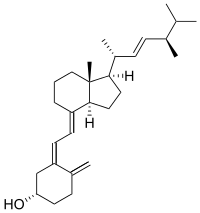Ergocalciferol
| Structural formula | ||||||||||||||||||||||
|---|---|---|---|---|---|---|---|---|---|---|---|---|---|---|---|---|---|---|---|---|---|---|

|
||||||||||||||||||||||
| General | ||||||||||||||||||||||
| Surname | Ergocalciferol | |||||||||||||||||||||
| other names |
|
|||||||||||||||||||||
| Molecular formula | C 28 H 44 O | |||||||||||||||||||||
| Brief description |
white, odorless solid |
|||||||||||||||||||||
| External identifiers / databases | ||||||||||||||||||||||
|
||||||||||||||||||||||
| Drug information | ||||||||||||||||||||||
| ATC code | ||||||||||||||||||||||
| Drug class |
Vitamin D 2 derivative |
|||||||||||||||||||||
| properties | ||||||||||||||||||||||
| Molar mass | 396.65 g · mol -1 | |||||||||||||||||||||
| Physical state |
firmly |
|||||||||||||||||||||
| Melting point |
116.5 ° C |
|||||||||||||||||||||
| solubility |
heavy in water (50 mg l −1 ) |
|||||||||||||||||||||
| safety instructions | ||||||||||||||||||||||
|
||||||||||||||||||||||
| As far as possible and customary, SI units are used. Unless otherwise noted, the data given apply to standard conditions . | ||||||||||||||||||||||
Ergocalciferol is a form of vitamin D , also called vitamin D 2 . Ergocalciferol is structurally a secosteroid . It was first obtained in 1922 by Adolf Windaus by photolysis of ergosterol ; the structure was clarified in the mid-1930s by Windaus and others. a.
Ingested with food, like vitamin D 3 , it is converted to calcitriol .
In a study by the University Clinic in Freiburg , it was demonstrated that cultivated mushrooms that were treated with UV-B radiation produced significant amounts of vitamin D 2 (491 μg or 19,640 IU per 100 g of cultivated mushrooms). The administration of the so-enriched pine mushrooms were vitamin D 2 - supplements equal. Similar results can also be achieved with shiitake , maitake , shimeji or other mushrooms. In the case of shiitake, values of up to 267,000 IU per 100 g of shiitake mushrooms could be achieved after exposure to sunlight for 14 hours.
Technical synthesis of vitamin D 2
The photochemical synthesis of vitamin D 2 was first discovered and investigated in 1927 by the Göttingen chemist Adolf Windaus . His work has enabled the fabrication of antirachitic vitamin D 2 by the pharmaceutical company E. Merck and Bayer (brand name Vigantol ), could be treated so that the vitamin deficiency of many children. For some years now, nutritional supplements have also been fortified with vitamin D 3 . The fortification of everyday foods with vitamin D is currently prohibited in Germany due to its toxicity. Since butter has a naturally high content, there is a single exemption for margarine in order to make it equivalent to its role model.
The technical synthesis of vitamin D 2 starts with ergosterol , which is obtained from yeast, and exposes it to UV radiation from a mercury vapor lamp , with all wavelengths outside the 270-300 nm band being filtered out. The resulting mixture of previtamin and vitamin can, depending on the temperature of the batch, contain a high concentration of vitamin D 2 , which is separated chromatographically . The production of vitamin D 3 also starts from the same precursor as occurs in the body, 7-dehydrocholesterol, which in turn is obtained by bromination of a cholesterol ester with subsequent dehydrobromination and saponification . Both photochemical reactions are expediently carried out in microreactors .
Trade names
FrekaVit (D), Vitalipid (D, A, CH)
Sterogyl (F)
Web links
- Ergocalciferol Compound - C05441 in the Kyoto Encyclopedia of Genes and Genomes
- Entry on Ergocalciferol in Flexikon , a Wiki of the DocCheck company
Individual evidence
- ↑ a b c d e Entry on ergocalciferol in the GESTIS substance database of the IFA , accessed on January 8, 2020(JavaScript required) .
- ↑ Entry on Ergocalciferol in the Classification and Labeling Inventory of the European Chemicals Agency (ECHA), accessed on February 1, 2016. Manufacturers or distributors can expand the harmonized classification and labeling .
- ↑ DAZ-online, No. 34/2006.
- ↑ P. Urbain, F. Singler, G. Ihorst, HK Biesalski, H. Bertz: Bioavailability of vitamin D2 from UV-B-irradiated button mushrooms in healthy adults deficient in serum 25-hydroxyvitamin D: a randomized controlled trial. In: European Journal of Clinical Nutrition. 65, 2011, pp. 965-971, doi: 10.1038 / ejcn.2011.53 . DRKS-ID of the study: DRKS00000195.
- ↑ Paul Stamets, fungi.com: Place Mushrooms in Sunlight to Get Your Vitamin D , 08/06/2012, retrieved April 29, 2014.
- ↑ US Patent 3185716
- ↑ US Patent 3367950
- ↑ US Patent 3,037,996
- ↑ US Patent 5543016

